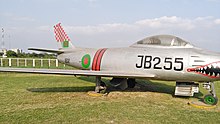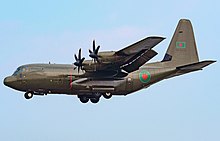Bangladesh Air Force
Furthermore, the BAF has a territorial role in providing tactical and strategic air transport and logistics capability for the country.
These numbers were gradually strengthened by the slow but steady defection from among the around 3,000 Bengali officers and airmen stationed and grounded in West Pakistan.
[13] Indian civilian authorities and the IAF donated 1 DC-3 Dakota (gifted by the Maharaja of Jodhpor), 1 Twin Otter plane, and 1 Alouette III helicopter for the new-born Bangladesh Air Force.
[14][10] The Bengali rank and file fixed up the World War II vintage runway at Dimapur Airport, then began rigging the aircraft for combat duty.
The Dakota was modified to carry 500 pound bombs, but for technical reasons, it was only used to ferry Bangladesh government personnel.
The Alouette III helicopter was rigged to fire 14 rockets from pylons attached to its side and had .303 Browning machine guns installed, in addition to having 1-inch (25 mm) steel plate welded to its floor for extra protection.
The Twin Otter boasted 7 rockets under each of its wings and could deliver ten 25 pound bombs, which were rolled out of the aircraft by hand through a makeshift door.
[17] The second Bangladesh Air Force attack was on 6 December 1971 at Moulvibazar Pakistani Army barracks under the command of Squadron Leader Sultan Mahmud, where Captain Shahabuddin Ahmed was co-pilot.
The Bangladesh Air Force gradually began to reoccupy the reform all the airbase structures throughout the country, HQ administrative buildings, fuel and weapons depots.
President Ziaur Rahman placed Hamidullah in charge of Command and Communication Control at the old Parliamentary building, present day Prime Minister's office.
Defence co-operation improved with Pakistan considerably under the government of Ziaur Rahman and the military regime of Hussain Muhammad Ershad in Bangladesh, which had grown more distant from its wartime ally India.
Common concerns over India's regional meddling have influenced strategic co-operation leading to a gift of several squadrons of refurbished Shenyang F-6 fighter aircraft from Pakistan to the Bangladesh Air Force in the late 1980s.
[21] The Bangladesh Air Force Academy (BAFA) received National Colours in 2003 from the then-Prime Minister Khaleda Zia.
The Recruits' Training School (RTS) was awarded with BAF Colours by ex-Chief of Air Staff (AVM Fakhrul Azam) in 2004.
BAF also evacuated immigrants and migrant workers, and airlifted tons of relief materials for home and abroad with their C-130B and C-130J cargo aircraft.
[31] Bangladesh has signed a government-to-government contract with the United Kingdom for the supply of two off-the-shelf C-130J aircraft currently in service with the Royal Air Force.
[34] On 20 June 2018, the Bangladesh Air Force signed a contract with China National Aero-Technology Import & Export Corporation (CATIC) for the procurement of seven K-8 jet training aircraft.
To perform its increasing duties and responsibilities, the air force is being divided into two separate commands: Southern and Northern.
The United Kingdom expressed its readiness to support Bangladesh with the procurement of high-calibre multi-role combat aircraft alongside other modernisation programmes.
[79] In October 2019, US officials said Bangladesh requested to purchase advanced military equipment from the United States, including multi-role combat fighters, attack helicopters and surface-to-air missile systems.
However, in late December 2021, it was reported that Bangladesh was now finalizing a government-to-government (G2G) deal with Russia to buy 8 Mi-28NEs with the necessary equipment, along with operations and maintenance training.
[83] In order to sign the agreement and for the first installment council, the Bangladesh Air Force requested the allocation of 6,300-crores taka for the 2021-22 financial year.
[85] Plans and procedures for the procurement of 16 Western-origin multirole fighter jet were established after cancellation of an older tender for 8 to 12 Russian-made MRCA.
According to Masihuzzaman Serniabat, the previous COAS, the Bangladesh Air Force ordered 24 trainer aircraft from Grob.




















